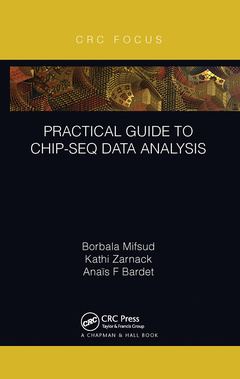Description
Practical Guide to ChIP-seq Data Analysis
Focus Computational Biology Series
Authors: Mifsud Borbala, Zarnack Kathi, Bardet Anaïs F
Language: English
Subjects for Practical Guide to ChIP-seq Data Analysis:
Keywords
ChIP Seq Dataset; ChIP Seq Signal; next-generation sequencing; ChIP Seq Peak; bioinformatics; ChIP Seq Data; computational biology; ChIP Seq; Anaïs Bardet; NCBI SRA; Kathi Zarnack; ChIP Seq Experiment; ChIP Sample; FDR Cutoff; BAM File; UCSC Genome Browser; DNA Methylation; Normalised Read Counts; Raw Sequencing Reads; Cat Peaks; FASTQ File; TF Motif; Reference Genome; WT Sample; Protein DNA Complex; Genome Browser; Empirical FDR; ChIP Seq Study; H3K27ac Peaks
23.94 €
In Print (Delivery period: 14 days).
Add to cartPublication date: 12-2021
· 13.8x21.6 cm · Paperback
71.13 €
In Print (Delivery period: 14 days).
Add to cartPublication date: 10-2018
· 13.8x21.6 cm · Hardback
Description
/li>Contents
/li>Biography
/li>
Chromatin immunoprecipitation sequencing (ChIP-seq), which maps the genome-wide localization patterns of transcription factors and epigenetic marks, is among the most widely used methods in molecular biology. Practical Guide to ChIP-seq Data Analysis will guide readers through the steps of ChIP-seq analysis: from quality control, through peak calling, to downstream analyses. It will help experimental biologists to design their ChIP-seq experiments with the analysis in mind, and to perform the basic analysis steps themselves. It also aims to support bioinformaticians to understand how the data is generated, what the sources of biases are, and which methods are appropriate for different analyses.
Chapter 1 Introduction to ChIP-seq
Chapter 2 Getting Started
Chapter 3 General Quality Control
Chapter 4 Genomic Alignment
Chapter 5 ChIP-seq-specific Quality Control
Chapter 6 Peak Calling
Chapter 7 Data visualisation
Chapter 8 Comparative Analysis
Chapter 9 Downstream Analyses
Borbala Mifsud is an assistant professor in Epigenomics at the Hamad Bin Khalifa University, Doha, Qatar. She is a computational biologist with a background in molecular biology and works on 3D chromatin conformation and the integration of epigenomic data.
Kathi Zarnack is a principal investigator in Computational RNA Biology at the Buchmann Institute for Molecular Life Sciences (BMLS), Goethe University Frankfurt, Germany. She is a computational biologist with a background in molecular biology and broad experience in analysing high-throughput sequencing data.
Anaïs F Bardet is a tenured researcher at the National Center for Scientific Research (CNRS) at the University of Strasbourg, France. She is a computational biologist and develops projects exploring the regulation of transcription factor binding.




